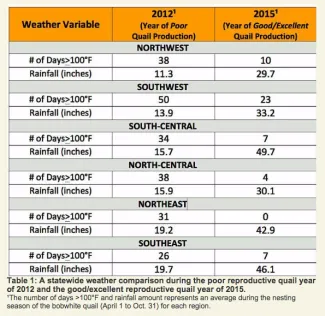Provided by Kyle Johnson, Quail Habitat Biologist
Oklahoma's excellent 2015-16 quail hunting season is still on the minds of many, and calls are already coming in seeking a forecast for the 2016-17 quail season. Although it is too early to know what may actually occur, clues are often found when looking at the weather. Furthermore, having some knowledge of recent quail population trends and habitat conditions can be helpful when forecasting the next quail season.
Fortunately, much research has been done to compare years of quail "booms" with years of quail "busts," and 2015 was certainly a quail boom for nearly all portions of Oklahoma with suitable quail habitat. Although habitat quality is important, biologists often contend that weather conditions play a major role in these boom and bust cycles, especially during the nesting season.
In general, quail booms can occur when low to moderate nesting-season temperatures are combined with ample rainfall, especially when these occur in consecutive years. Even during years of moderate to high rainfall, quail production can be quite poor if the temperatures are extreme. Moderately good quail production is still possible even during dry years if temperatures remain cool. However, years with exceptional heat and drought, as Oklahoma experienced during 2011 and 2012, will nearly always result in poor quail production.

A general comparison of the weather conditions that occurred during the poor quail year of 2012 to the excellent quail year of 2015 can provide some insight into how 2016 may stack up (see Table 1). It is important to remember that consecutive years of poor production can compound the problem. Likewise, consecutive years of good to excellent production can boost quail numbers to population levels that haven't been observed in quite some time. Sometimes, a year of excellent quail production and habitat conditions can help buffer the impacts the following year if the weather is unfavorable for nesting and brood rearing. Although the fine details between temperature and rainfall can vary, extended periods of triple-digit temperatures combined with below-average rainfall can have devastating effects on quail during the nesting season.
So, how is the 2016-17 quail hunting season looking now? Areas with a carryover of good to excellent habitat conditions resulting from last year's plentiful rainfall should give breeding quail a better chance for a successful nesting season than areas with poor to fair quail habitat. The key now is to monitor the rainfall and temperatures for the rest of summer and early fall to determine if they more closely align with conditions in 2012 or conditions in 2015. Which direction the weather tilts between the two years should provide an indicator of what may be observed in the field this upcoming quail season. Let's hope it leans in the direction of 2015.
For questions about improving habitat for upland game birds, including free habitat evaluations, contact Kyle Johnson, quail habitat biologist, at (405) 684-1929 or check out the Oklahoma Quail Habitat Guide on the Oklahoma Department of Wildlife Conservation website, wildlifedepartment.com.